First, a bit about naphthalene because I unknowingly bathed in water contaminated with it for years after Encana’s secret illegal fracs:
Medlineplus: Naphthalene poisoning
… Poisoning from naphthalene destroys or changes red blood cells so they cannot carry oxygen. This can cause organ damage.
CDC PUBLIC HEALTH STATEMENT on NAPHTHALENE, 1-METHYLNAPHTHALENE, AND 2-METHYLNAPHTHALENE
… You may be exposed by breathing, eating, or drinking the substance, or by skin contact. … Naphthalene can become weakly attached to soil or pass through the soil particles into underground water. ![]() In 2004, Encana injected 18 Million litres of frac fluids directly into Rosebud’s drinking water aquifers! Secretly and illegally, of course, led by Order of Canada recipient, CEO Gwyn Morgan.
In 2004, Encana injected 18 Million litres of frac fluids directly into Rosebud’s drinking water aquifers! Secretly and illegally, of course, led by Order of Canada recipient, CEO Gwyn Morgan.![]()
… If dairy cows are exposed to naphthalene, some naphthalene will be in their milk; if laying hens are exposed, some naphthalene will be in their eggs. ![]() In many areas, “regulators” allow oil and gas companies to dump their chemical laden process water after frac’ing into water ways, inject it into drinking water aquifers, and or pipeline and sell it to farmers for crop irrigation and ranchers for livestock watering.
In many areas, “regulators” allow oil and gas companies to dump their chemical laden process water after frac’ing into water ways, inject it into drinking water aquifers, and or pipeline and sell it to farmers for crop irrigation and ranchers for livestock watering.![]()
… If you live near a hazardous waste site and have a well used for drinking water, you might be exposed to naphthalene, 1-methylnaphthalene, or 2-methylnaphthalene. For this to happen, the chemicals must pass through the soil and dissolve in the underground water that supplies your well.
… Once naphthalene, 1-methylnaphthalene, or 2-methylnaphthalene enter your body, small amounts will dissolve in your blood. Your blood carries them to your liver and other organs. … Naphthalene can move from your blood to your baby’s blood. Once your baby is born, naphthalene may also be carried from your body to your baby’s body through your milk. …
Laboratory rabbits, guinea pigs, mice, and rats sometimes develop cataracts (cloudiness) in their eyes after swallowing naphthalene at high dose levels. It is not certain whether cataracts also develop in humans exposed to naphthalene, but the possibility exists.
When mice or rats breathed in naphthalene vapors daily throughout their lives (2 years), cells in the lining of their noses or lungs were damaged. Some exposed female mice also developed lung tumors. Some exposed male and female rats developed nose tumors. …
Based on these results from animal studies, the U.S. Department of Health and Human Services concluded that naphthalene is reasonably anticipated to be a human carcinogen. The International Agency for Research on Cancer (IARC) concluded that naphthalene is possibly carcinogenic to humans, because there is enough evidence that naphthalene causes cancer in animals, but not enough evidence about such an effect in humans. Under the EPA 1986 cancer
guidelines, naphthalene was assigned to Group C – possible human carcinogen.
When mice were fed food containing 1-methylnaphthalene or 2-methylnaphthalene for most of their lives (81 weeks), the gas-exchange part of the lungs of some mice became filled with an abnormal material. This type of lung injury is called pulmonary alveolar proteinosis. … Pulmonary alveolar proteinosis has been seen in some people, but the cause of this uncommon lung disease in humans is unknown. ![]() Bodes very badly for people living frac’d, sick with Covid-19.
Bodes very badly for people living frac’d, sick with Covid-19.![]()
… Newborns or infants are thought to be especially susceptible to this effect on the blood, because their bodies are less able to get rid of naphthalene than adults.
Newborn mice appear to be more susceptible to lung injury than adult mice, when they are injected with naphthalene. These results suggest that children may be more susceptible to lung injury from naphthalene than adults. Scientists do not know if lung injury from breathing in naphthalene in childhood may lead to lung disease later in life.
… Some regulations and recommendations for naphthalene, 1-methylnaphthalene, and 2-methylnaphthalene include the following:
… OSHA set a limit of 10 parts per million (ppm) for the level of naphthalene in workplace air over an 8-hour workday. NIOSH set a limit of 500 ppm for the level of naphthalene in workplace air expected to be immediately dangerous to life or health. Exposure to workplace air concentrations above this limit for more than 30 minutes would be expected to impair a worker’s ability to escape the contaminated workplace. ![]() Why NO limits for frac’d families or their pets and livestock?
Why NO limits for frac’d families or their pets and livestock?![]()
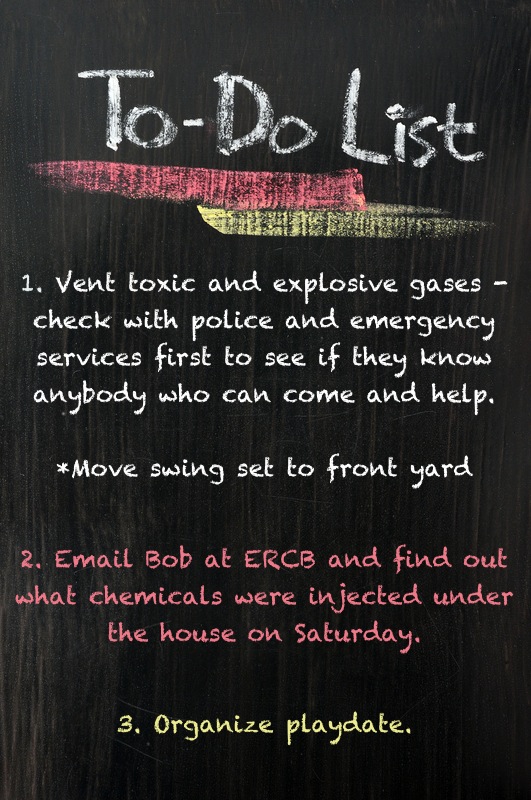
Image by FrackingCanada
EPA recommends that children not drink water with over 0.5 ppm naphthalene for more than 10 days or over 0.4 ppm for any longer than 7 years. Adults should not drink water with more than 1 ppm for more than 7 years. For water consumed over a lifetime (70 years), EPA suggests that it contain no more than 0.1 ppm naphthalene. ![]() An expert reported to me that napthalene exposure via skin is much more harmful to our health than ingesting it. Why no protection limits for bathing in water contaminated with frac fluids, notably as so many contain napthalene (details in the paper below)?
An expert reported to me that napthalene exposure via skin is much more harmful to our health than ingesting it. Why no protection limits for bathing in water contaminated with frac fluids, notably as so many contain napthalene (details in the paper below)?![]()
2018: Naphthalene Toxicity: Methemoglobinemia and Acute Intravascular Hemolysis
Abstract
Naphthalene poisoning is a rare form of toxicity that may occur after ingestion, inhalation, or dermal exposure to naphthalene-containing compounds…. Clinically, patients present with acute onset of dark brown urine, watery diarrhea, and non-bloody bilious vomiting 48-96 hours after exposure. Vital sign abnormalities include fever, tachycardia, hypotension, and persistent pulse oximetry readings of 84%-85% despite oxygen supplementation. Laboratory workup demonstrates hyperbilirubinemia with indirect predominance, hemolytic anemia, methemoglobinemia, and renal dysfunction.
Treatment options include supportive care, red cell transfusion, ascorbic acid, methylene blue, and N-acetylcysteine. ![]() When companies like EncanaOvintiv frac you in secret (and your water supply) and keep their toxic chemical additives secret (with regulators and courts not compelling companies to fully disclose what they are poisoning us with), how do health-harmed people get medical help? Instead of seeking treatment (because Encana didn’t even tell my community it was frac’ing us, never mind had illegally frac’d our drinking water supply), I kept bathing in and cooking with naphthalene contaminated water, and breathing it venting from water taps for years (along with other secret man-made frac chemicals, as well as extremely dangerous levels of methane and ethane)?
When companies like EncanaOvintiv frac you in secret (and your water supply) and keep their toxic chemical additives secret (with regulators and courts not compelling companies to fully disclose what they are poisoning us with), how do health-harmed people get medical help? Instead of seeking treatment (because Encana didn’t even tell my community it was frac’ing us, never mind had illegally frac’d our drinking water supply), I kept bathing in and cooking with naphthalene contaminated water, and breathing it venting from water taps for years (along with other secret man-made frac chemicals, as well as extremely dangerous levels of methane and ethane)?
During the two years after Encana’s illegal frac’ing of the aquifers that supply my water well, I was getting more and more bizarre geometric shaped bruising on all parts of my body except my face and neck (I don’t bathe with my head under water) and suffered a brutally painful rash that took years to go away. An expert I consulted before I knew what was in my water told me naphthalene is a red blood cell destroyer, often in frac additives, and bathing in water contaminated with it can cause what was happening to me.![]()
Hazardous substances as the dominant non-methane volatile organic compounds with potential emissions from liquid storage tanks during well fracturing: A modeling approach by Huan Chen and Kimberly E. Carter, Aug 15, 2020, J Environmental Management, Vol 268, https://doi.org/10.1016/j.jenvman.2020.110715
The email hidden; JavaScript is required" target="_blank" rel="noreferrer noopener">paper
Highlights
•Potential VOC emissions from chemical storage tanks was 8.11 × 105 kg for 72,032 wells.
•Emissions from storage tanks were dominated by NMVOCs due to their volatilities.
•Of NMVOC emissions, 95% were from 60 hazardous and 17% from carcinogens compounds.
•Methanol, formaldehyde, 2-propanol, and ethanol caused 92% NMVOC emission.
Abstract
Chemical additives used in hydraulic fracturing fluids (HFFs) are made up of various organic compounds that are potential human carcinogens. To estimate the emissions from these organic constituents in on-site liquid storage tanks, studies were performed using the AP-42 model on data collected from 72,023 wells put into production using hydraulic fracturing between 2008 and 2014 in the United States. Results show that a total of 8.11 × 105 kg volatile organic compounds (VOCs) were potentially emitted from liquid storage tanks during fracturing operations, which was relatively low compared to other sources/activities in well fracturing. The median well emission roughly increased from 0.110 to 0.786 kg per well in 2008 and 2014, respectively, and was primarily due to the increase in the volume of chemical additives for fracturing one well.
Of NMVOC emissions, 95.1% was contributed by 60 compounds listed on the priority list of hazardous substances defined by the Agency for Toxic Substances & Disease Registry (ATSDR), while 16.7% was caused by 15 carcinogenic compounds. Specially, methanol, formaldehyde, 2-propanol, and ethanol accounted for 55.5%, 16.6%, 11.7%, and 8.31% of NMVOC emissions. Our study highlights methanol, formaldehyde, 2-propanol, and ethanol as the targeted compounds for reducing organic emissions and occupational inhalation exposures related to storage tank operations.
Graphical abstract

Download high-res image (108KB)
Download : Download full-size image
… The chemical additives used in HFFs may consist of friction reducers, scale and corrosion inhibitors, and biocides (Arthur et al., 2009; Gregory et al., 2011; Aminto and Olson, 2012), which may be toxic or form toxic byproducts that could
create adverse human health effects (Aminto and Olson, 2012). The U.S.
House of Representatives (2011) has reported that 95 additives used for
hydraulic fracturing operations contain 13 potential or proven carcinogenic
compounds. …
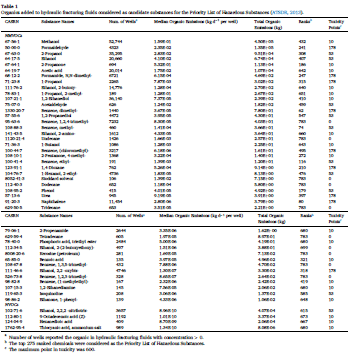
From Table 1: Organics added to hydraulic fracturing fluids considered as candidate substances for the Priority List of Hazardous Substances (ATSDR, 2013):
CASRN Substance Names
NMVOCs
67-56-1 Methanol
50-00-0 Formaldehyde
67-63-0 2-Propanol
64-17-5 Ethanol
67-64-1 2-Propanone
64-19-7 Acetic acid
68-12-2 Formamide, N,N-dimethyl-
71-23-8 1-Propanol
111-76-2 Ethanol, 2-butoxy-
78-83-1 1-Propanol, 2-methyl-
107-21-1 1,2-Ethanediol
75-07-0 Acetaldehyde
1330-20-7 Benzene, dimethyl-
57-55-6 1,2-Propanediol
95-63-6 Benzene, 1,2,4-trimethyl-
108-88-3 Benzene, methyl-
141-43-5 Ethanol, 2-amino-
1120-21-4 Undecane
71-36-3 1-Butanol
100-44-7 Benzene, (chloromethyl)-
108-10-1 2-Pentanone, 4-methyl-
100-41-4 Benzene, ethyl-
123-91-1 1,4-Dioxane
104-76-7 1-Hexanol, 2-ethyl-
8052-41-3 Stoddard solvent
112-40-3 Dodecane
108-95-2 Phenol
57-13-6 Urea
91-20-3 Naphthalene
629-50-5 Tridecane
CASRN Substance Names
79-06-1 2-Propenamide
629-59-4 Tetradecane
78-40-0 Phosphoric acid, triethyl ester
112-34-5 Ethanol, 2-(2-butoxyethoxy)-
8008-20-6 Kerosine (petroleum)
65-85-0 Benzoic acid
108-67-8 Benzene, 1,3,5-trimethyl-
111-46-6 Ethanol, 2,2 -oxybis-
526-73-8 Benzene, 1,2,3-trimethyl-
98-82-8 Benzene, (1-methylethyl)-
107-15-3 1,2-Ethanediamine
119-65-3 Isoquinoline
98-86-2 Ethanone, 1-phenyl-
NVOCs
102-71-6 Ethanol, 2,2,2 -nitrilotris-
112-80-1 9-Octadecenoic acid (Z)-
124-04-9 Hexanedioic acid
1762-95-4 Thiocyanic acid, ammonium salt

From Table 2: Organics added to hydraulic fracturing fluids that are considered potential or known carcinogens:
CASRN Substance Names
NMVOCs
106-89-8 Oxirane, (chloromethyl)-
107-13-1 2-Propenenitrile
123-91-1 1,4-Dioxane
50-00-0 Formaldehyde
542-75-6 1-Propene, 1,3-dichloro-
62-56-6 Thiourea
71-43-2 Benzene
75-07-0 Acetaldehyde
75-09-2 Methane, dichloro-
75-21-8 Oxirane
75-52-5 Methane, nitro-
75-56-9 Oxirane, methyl-
79-06-1 2-Propenamide
91-20-3 Naphthalene
98-82-8 Benzene, (1-methylethyl)-
NVOCs
117-81-7 1,2-Benzenedicarboxylicacid, bis(2-ethylhexyl) ester
139-13-9 Glycine, N,N-bis(carboxymethyl)-
![]() A number of the above chemicals were found in Rosebud’s drinking water by the regulator after Encana illegally frac’d it. Even with Ernst’s lawsuit, the chemicals injected into the community’s fresh water aquifers remain withheld by Encana. Alberta Rules of Court do not allow trade secrets in lawsuits, but in my experience, legal rules are used against the citizen plaintiff, not against law-violating corporations, law-violating regulators, lying, rule-violating lawyers or lying dirty judges doing the harming or pissing on the rule of law and their own rules.
A number of the above chemicals were found in Rosebud’s drinking water by the regulator after Encana illegally frac’d it. Even with Ernst’s lawsuit, the chemicals injected into the community’s fresh water aquifers remain withheld by Encana. Alberta Rules of Court do not allow trade secrets in lawsuits, but in my experience, legal rules are used against the citizen plaintiff, not against law-violating corporations, law-violating regulators, lying, rule-violating lawyers or lying dirty judges doing the harming or pissing on the rule of law and their own rules.![]()
… Though most of states are requiring companies to disclose the chemicals used![]() with fabulous loophole for industry allowing trade secrets for what ever chemicals the companies want to keep secret, and worse, no frac chemicals need to be disclosed before frac’ing preventing anyone from appropriately and completely testing their drinking water supply, or knowing what families, pets and livestock will be forced to breath during frac operations, waste dumping, flaring/venting
with fabulous loophole for industry allowing trade secrets for what ever chemicals the companies want to keep secret, and worse, no frac chemicals need to be disclosed before frac’ing preventing anyone from appropriately and completely testing their drinking water supply, or knowing what families, pets and livestock will be forced to breath during frac operations, waste dumping, flaring/venting![]() (Konschnik and Dayalu, 2016), there are no regulations regarding which chemicals can or cannot be used in fracturing wells. Until now, most studies (Elsner and Hoelzer, 2016; Stringfellow et al., 2017; Xu et al., 2019) focus on the characterization (e.g., toxicity and structure) of chemical additives used in fracturing wells. On the other side, the selection of chemical species by operators primarily depends on the required functions (e.g., biocides) and, most important, the cost. … Among the organic emissions from hydraulic fracturing, more concerning are the emissions from toxic organics.
(Konschnik and Dayalu, 2016), there are no regulations regarding which chemicals can or cannot be used in fracturing wells. Until now, most studies (Elsner and Hoelzer, 2016; Stringfellow et al., 2017; Xu et al., 2019) focus on the characterization (e.g., toxicity and structure) of chemical additives used in fracturing wells. On the other side, the selection of chemical species by operators primarily depends on the required functions (e.g., biocides) and, most important, the cost. … Among the organic emissions from hydraulic fracturing, more concerning are the emissions from toxic organics.
Our study found that 95.14% of NMVOC emissions were from 60 compounds belonging to the 2011 ATSDR list of candidate substances while 16.73% of NMVOC emissions were produced by 15 compounds listed in the U.S. DHHS’s 13th Report on Carcinogens (NTP, 2014). Among 60 NMVOCs and 13 NVOCs identified in HFFs and found on the 2011 ATSDR lists, fourteen NMVOCs and one NVOCs are on the Priority List of Hazardous Substances (Table 1 and Table S8). Three organics with the highest toxicity points were 1,10 -oxybis 2-chloro-ethane, benzene, and thiourea. Methanol, 2-propanol, and ethanol produced total organic emissions…accounting for ~76% of the total NMVOCs emissions, suggesting reducing these compounds is critical for reducing the organic emissions from storage tanks.
Seventeen NMVOCs and NVOCs in the HFFs were reported as either known human
carcinogens or reasonably anticipated to be a human carcinogen (RAHC), and listed in the 13th Report on Carcinogens (Table 2) (NTP, 2014). Of these seventeen compounds, the highest median organic emission…belonged to benzene…. The average air concentrations of 0.67–1.01 ppb-C for benzene were reported by Lim et al. (2019) at five monitoring sites surrounding 64 to431 gas wells within a 5-km radius in Texas however; these sites were also related to various activities in oil and gas development and production (e.g., gas spilling/leakage).
Three out of seventeen organic compounds were present in more than 1000 wells’ HFFs: naphthalene ![]() After Encana frac’d my community’s drinking water aquifers, covered up by Alberta “regulators” AER and Alberta Environment, naphthalene was found in my water as well as other man-made chemicals used in the oil and gas industry, and extremely dangerous levels of methane and ethane (the purpose of frac’ing is to force reluctant hydrocarbons to let go from formations they are naturally tightly adsorbed to, but of course, Encana, AER and Alberta Environment blamed me, my neigbours and nature, not Encana/Ovintiv or the company’s crimes)
After Encana frac’d my community’s drinking water aquifers, covered up by Alberta “regulators” AER and Alberta Environment, naphthalene was found in my water as well as other man-made chemicals used in the oil and gas industry, and extremely dangerous levels of methane and ethane (the purpose of frac’ing is to force reluctant hydrocarbons to let go from formations they are naturally tightly adsorbed to, but of course, Encana, AER and Alberta Environment blamed me, my neigbours and nature, not Encana/Ovintiv or the company’s crimes)![]() , formaldehyde, and 2-propenamide…. Previous studies also reported naphthalene in more than 20% of the FracFocus reports (Rogers et al., 2015). The estimated total organic emission for formaldehyde…accounted for 16.6% of NMVOCs emissions. This indicates that inhibiting the usage of formaldehyde could significantly reduce the emissions and toxicity of NMVOC from storage tanks.
, formaldehyde, and 2-propenamide…. Previous studies also reported naphthalene in more than 20% of the FracFocus reports (Rogers et al., 2015). The estimated total organic emission for formaldehyde…accounted for 16.6% of NMVOCs emissions. This indicates that inhibiting the usage of formaldehyde could significantly reduce the emissions and toxicity of NMVOC from storage tanks.
Flowback pits have a larger surface area and are open to the atmosphere making evaporation from these components more favorable than the closed chemical storage tanks. One study (Bloomdahl et al., 2014) reported the average emissions per well from the open flowback pits for xylenes, toluene, benzene, and ethylbenzene…. These results suggest that the emissions from the open flowback pits were not always higher than those from the storage tanks. It may be because the chemical concentrations in the storage tanks are much higher than those in the open flowback pits. For example, the average concentration for xylenes, toluene, benzene, and ethylbenzene in the flowback pits was 0.390, 0.240, 0.124, and 0.049 ppm, respectively (Bloomdahl et al., 2014). Chittick and Srebotnjak (2017) reported that the average concentration of these chemicals in produced water for approximately 500 hydraulic fracturing wells was 0.84 ppm for xylenes, 1.1 ppm for toluene, 0.63 ppm for benzene, 0.18 ppm for ethylbenzene.
… This study also observed a trend in the number of wells fractured that increased annually from two in 2008 to 20,177 in 2014. The increasing number of wells from year to year may be partially attributed to the participation of states and gas and oil companies in submitting information for their fractured well to ![]() TradeSecret
TradeSecret![]()
FracFocus.
![]() Now we find out, years after the fact, in a published paper no less, the real reason for TradeSecretFocus (aka FracFocus is Bogus).
Now we find out, years after the fact, in a published paper no less, the real reason for TradeSecretFocus (aka FracFocus is Bogus).![]()
The median value for the well emissions increased roughly from 0.110 kg per well in 2008 to 0.786 kg per well in 2014 (Fig. 4a).
… The increasing volume of chemical additives, rather than the amount of
emissions per m3 of chemical additives, may account for the increasing well emissions.
Though hydrocarbons, primarily methane, are the main components of natural gas and are considered as the dominant VOCs from hydraulic fracturing (Allen et al., 2013; Zavala-Araiza et al., 2014; Karion et al., 2015), attention should be paid to the NMVOCs from chemical storage tanks, because of their potential for high toxicity (Elliott et al., 2017) and potential adverse occupational inhalation exposures (Chen and Carter, 2017b).
3.4. Strengths and limitations
The novelty and strength of this study is that a significant number of fractured wells were included and their field and environmental conditions (e.g., air temperature) were considered when estimating the potential emissions of the chemical additives from their storage tanks. Moreover, the validity of our outcomes was confirmed through sensitivity and uncertainty analysis on the emission model (AP-42).
However, our study still has some drawbacks, primarily due to the data quality. Two research limitations in our study should be noted.
First, some chemical compounds were listed as proprietary ingredients in their reports to the www.FracFocus.org database and were not considered in this study. These compounds may be toxic/carcinogenic and may contribute to the emissions from liquid storage tanks for chemical additives used at hydraulic fracturing sites.
Second, there were more than 2000 individual chemical additives (including inorganic and organic compounds) reported by well operators. The chemicals may be used or located on the 72,203 well pads, but we only found complete information for 475 organic species in the EPI Suite™ software (U.S. EPA, 2015). Therefore, the emissions of the approximately 1500 remaining compounds (including a large number of organic compounds) were not estimated due to the lack of their physical/chemical properties. Both limitations will result in the underestimation of the results in this study.
Conclusions
… The emissions from chemical storage tanks were much greater for NMVOCs due to their high volatilities, other than liquid surface temperature and percentage in storage tanks. Of the total organic emissions caused by all NMVOCs, approximately 95.14% were caused by substances on the ATSDR candidate substances list.
Moreover, 16.73% of NMVOC emissions were from 15 compounds listed in the U.S. DHHS’s 13th Report on Carcinogens, suggesting the potential for high toxicity of fugitive emissions from storage tanks. The median well emissions were 0.110 and 0.786 kg per well in 2008 and 2014, respectively. The increase in well emission (kg per well) was due to the increase in the volume of chemical additives used to fracture one well. Additionally, the increasing volume of chemical additive used per well may be the result of the increasing horizontal lateral length along with time.

Refer also to:
And, to be perfectly frank, when you do energy law, as I do, or corporate litigation, you’re not dealing with life and death situations and people whose lives have been turned upside down, plaintiffs who are weeping. It’s just about money.
2012, Calgary managing partner for Osler Hoskin Harcourt, Maureen Killoran, Encana’s lawyer in Ernst vs Encana.
2019: Pennsylvania: Frac’ing under investigation following surge of rare cancer cases
2013: Baytex submits action plan to ERCB following accidental land spraying with crude oil
2012: Where’s Encana’s “action” plan to clean it’s vile waste “spraying,” aka dumping, on foodland at Rosebud?
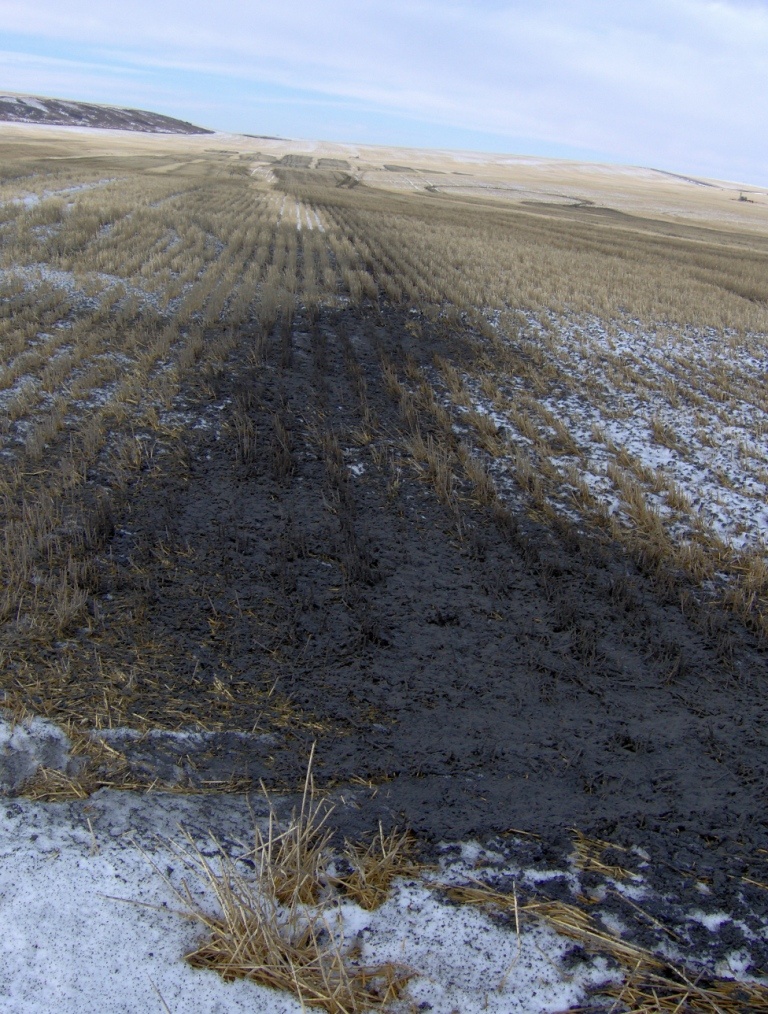
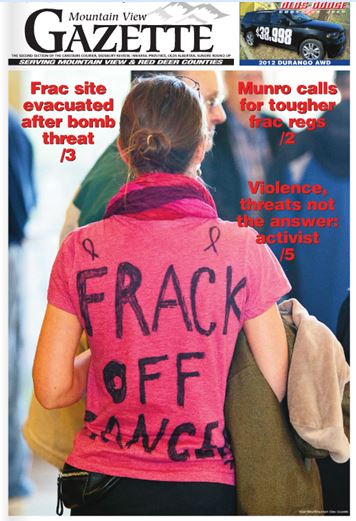
Kimberly Mildenstein attending Mountain View County Frac Presentation by Councilor Paddy Munroe
2011: Encana frac’er Trican donates $5 million for cancer research (Trican had a sweet massive contract with Encana; they frac’d Rosebud and many other communities)
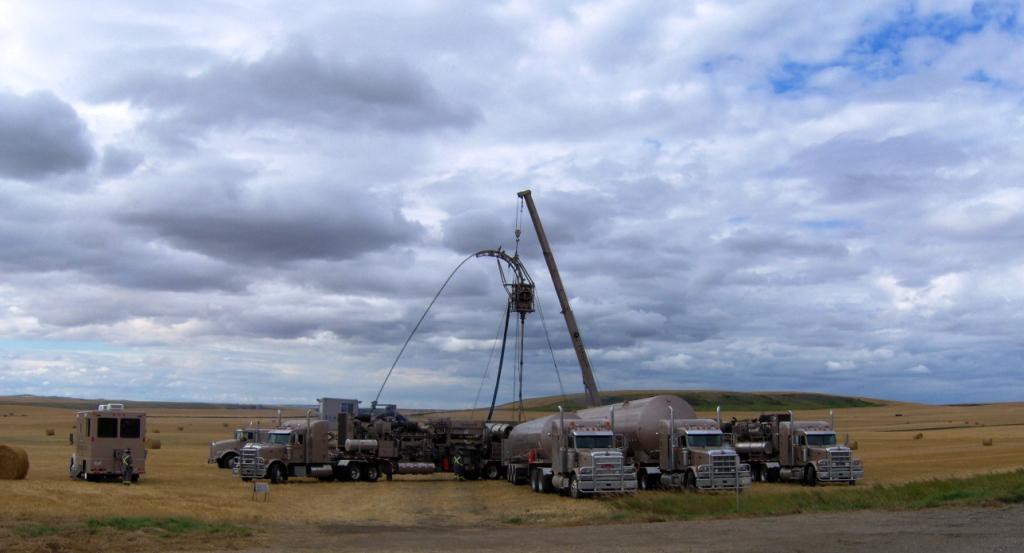
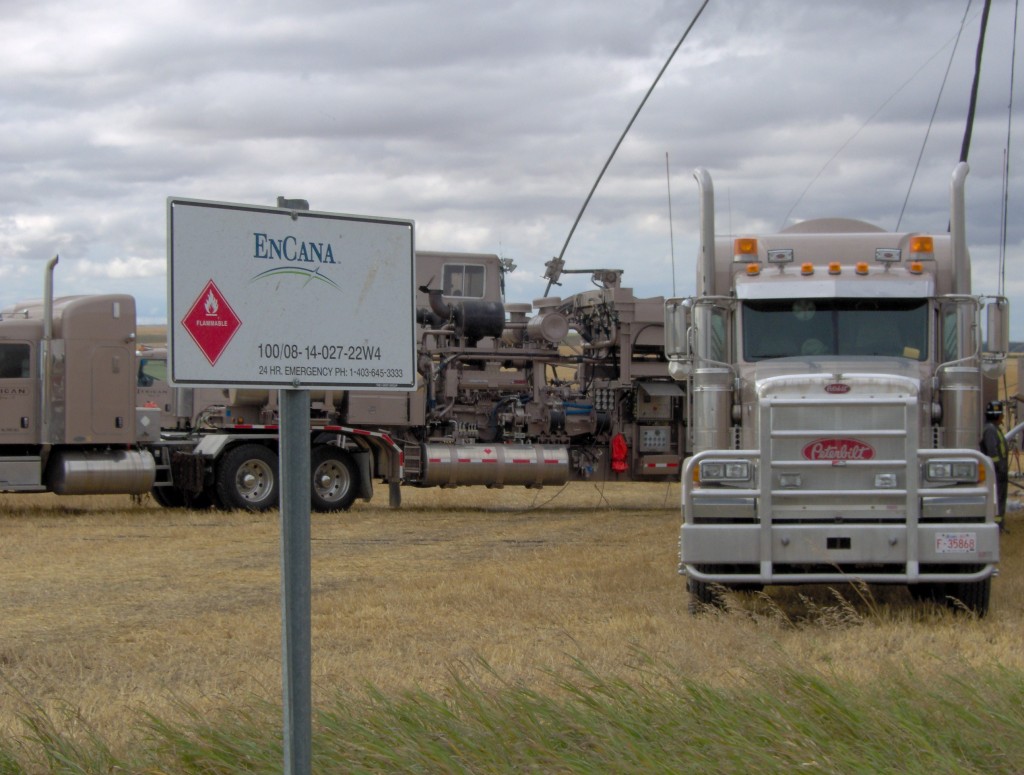
Above photos: Trican frac’ing for Encana/now Ovintiv above the base of groundwater protection near Ernst’s and the Hamlet of Rosebud’s already frac’d water wells, during the regulator’s investigation of the community-wide drinking water contamination.
When impacted families asked the regulator why they were not ordering Encana to cease frac’ing during their investigation, the regulator replied that they do not have the authority to tell Encana what to do or not do. “Regulator” Alberta KKK Style.
